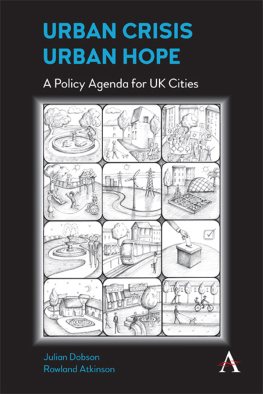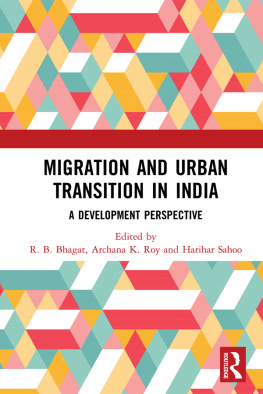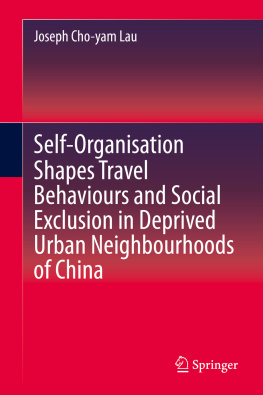Sadan Jha - Neighbourhoods in Urban India: In Between Home and the City
Here you can read online Sadan Jha - Neighbourhoods in Urban India: In Between Home and the City full text of the book (entire story) in english for free. Download pdf and epub, get meaning, cover and reviews about this ebook. year: 2021, publisher: Bloomsbury UK, genre: Romance novel. Description of the work, (preface) as well as reviews are available. Best literature library LitArk.com created for fans of good reading and offers a wide selection of genres:
Romance novel
Science fiction
Adventure
Detective
Science
History
Home and family
Prose
Art
Politics
Computer
Non-fiction
Religion
Business
Children
Humor
Choose a favorite category and find really read worthwhile books. Enjoy immersion in the world of imagination, feel the emotions of the characters or learn something new for yourself, make an fascinating discovery.
- Book:Neighbourhoods in Urban India: In Between Home and the City
- Author:
- Publisher:Bloomsbury UK
- Genre:
- Year:2021
- Rating:5 / 5
- Favourites:Add to favourites
- Your mark:
- 100
- 1
- 2
- 3
- 4
- 5
Neighbourhoods in Urban India: In Between Home and the City: summary, description and annotation
We offer to read an annotation, description, summary or preface (depends on what the author of the book "Neighbourhoods in Urban India: In Between Home and the City" wrote himself). If you haven't found the necessary information about the book — write in the comments, we will try to find it.
Sadan Jha: author's other books
Who wrote Neighbourhoods in Urban India: In Between Home and the City? Find out the surname, the name of the author of the book and a list of all author's works by series.
Neighbourhoods in Urban India: In Between Home and the City — read online for free the complete book (whole text) full work
Below is the text of the book, divided by pages. System saving the place of the last page read, allows you to conveniently read the book "Neighbourhoods in Urban India: In Between Home and the City" online for free, without having to search again every time where you left off. Put a bookmark, and you can go to the page where you finished reading at any time.
Font size:
Interval:
Bookmark:

Neighbourhoods in Urban India
Neighbourhoods in Urban India
In between Home and the City
Edited by
Sadan Jha
Dev Nath Pathak
Amiya Kumar Das

BLOOMSBURY INDIA
Bloomsbury Publishing India Pvt. Ltd
Second Floor, LSC Building No. 4, DDA Complex, Pocket C 6 & 7,
Vasant Kunj, New Delhi, 110070
BLOOMSBURY, BLOOMSBURY ACADEMIC INDIA and the Diana logo are trademarks of Bloomsbury Publishing Plc
First published in India 2021
This edition published 2021
Copyright Sadan Jha, Dev Nath Pathak, Amiya Kumar Das, 2021
Sadan Jha, Dev Nath Pathak, Amiya Kumar Das have asserted their right under the Indian Copyright Act to be identified as the Editors of this work
All rights reserved. No part of this publication may be reproduced or transmitted in any form or by any means, electronic or mechanical, including photocopying, recording or any information storage or retrieval system, without the prior permission in writing from the publishers
This book is solely the responsibility of the author and the publisher has had no role in the creation of the content and does not have responsibility for anything defamatory or libellous or objectionable
Bloomsbury Publishing Plc does not have any control over, or responsibility for, any third-party websites referred to or in this book. All internet addresses given in this book were correct at the time of going to press. The author and publisher regret any inconvenience caused if addresses have changed or sites have ceased to exist, but can accept no responsibility for any such changes
ISBN: PB: 978-93-90252-62-6; eBook: 978-93-90252-64-0
2 4 6 8 10 9 7 5 3 1
Created by Manipal Digital Systems
To find out more about our authors and books visit www.bloomsbury.com and sign up for our newsletters
Early Reviews
Neighbourhoods in Urban India is a brilliant exploration of urbanism between the concept city and the lived city. With a multidisciplinary approach, the volume focuses on urban life lived between home and the world, institutions and experiences, representations and affects. While the theoretically sharp introduction alone is worth the price of the book, its fascinating range of empirically rich and analytically sophisticated excavations of neighbourhoods make the volume a must-have in the bookshelf on South Asian urban studies.
Gyan Prakash, Professor of History, Princeton University, and the author of Mumbai Fables (2010)
A welcome addition to the literature of urban studies, this book on neighbourhoods opens up a new dimension to comprehend urban India. A must-read for those who wish to study the micro aspects of contemporary urbanity.
Sujata Patel, Distinguished Professor, Department of Sociology, Savitribai Phule Pune University, Maharashtra
The neighbourhood has been a much referenced but significantly understudied component of Indian urbanism. This important collection by a new generation of scholars thankfully fills this gap, bringing together philosophical debates, ethnographic enquiries and histories of planning. We enter the debates on memory and history, time and space, regional, national and global movements of planning. The arguments flow from research conducted in cities and towns across IndiaAhmedabad, Delhi, Banaras, Lucknow, Kolkata, Darbhangaand much more. This book is a powerful addition to the study of Indian urbanism.
Ravi Sundaram, Senior Fellow, Centre for the Study of Developing Societies (CSDS), Delhi
Contents
| : | A rough illustration of the location of the Kshi Mumukshu Bhawan near Assi Ghat in Banaras. Image credit: author66 |
| : | The main gate of the Kshi Mumukshu Bhawan near Assi Ghat in Banaras, December 2017. Photo credit: author67 |
| : | An illustration of the route map of the Kshi Mumukshu Bhawan campus in Banaras. Image credit: author72 |
| : | One of the two residential compounds at Lohia Chowk in Kshi Mumukshu Bhawan, Banaras, where the majority of the residents are Telugu-speaking Kshivsis, January 2018. Photo credit: author73 |
| : | The atithishala compound in Kshi Mumukshu Bhawan, December 2017. Photo credit: author75 |
| : | The ground floor of atithishala, mostly occupied by the locals and other Hindi-speaking Kshivsis, and a few quarters on the second storey, inhabited by Telugu-speaking residents, in Kshi Mumukshu Bhawan, December 2017. Photo credit: author83 |
| : | Bajrang Dal written on an electricity pole in red on white background (in original). Photo credit: author164 |
| : | AAMSU (All Assam Muslim Students Union) written on a tea-shop next to a mosque in Golakganj. Golakganj Bazar Jama Masjid is written in Assamese. Photo credit: author164 |
| : | Join Deshi Yuba Parishad Assam (DYPA) written on a pillar and DYPA Zindabad written in Assamese. Photo credit: author165 |
| : | MohallMata, Mandvi ni Pol, Ahmedabad, October 2019. Photo credit: author224 |
| : | Lucknow map with precincts of government housing highlighted. Map credit: author232233 |
| : | A diagram of Clarence Perrys Neighbourhood Unit, illustrating the spatiality of the core principles of the concept. Map credit: Perry [1998] 1929, New York Regional Survey, Vol. 7235 |
| : | Robert Napiers post-mutiny proposal for Lucknow, 1858. Map credit: adapted by the author from Oldenburg (1984: 32)238 |
| : | 1955 Lucknow Development Plan residential categories. Image credit: author240 |
| : | Cantonment area as represented in 1893. Bungalow typology was the desirable urban lifestyle that the architectural design emulated. Map credit: adapted by the author from Bartholomew et al. (1893)242243 |
| : | House layout curated by Deshpande. Map credit: Deshpande (1943: 311)245 |
| : | Pricerent ratio in five cities in India. Apt denotes flats in apartments; Ind denotes independent houses/bungalows. Image credit: authors260 |
| : | Pricerent ratio in five neighbourhoods in Delhi. Apt denotes flats in apartments; Ind denotes independent houses/bungalows. Image credit: authors266 |
| : | New Capital Area outgrowth. Map credit: Patna Improvement Trust Master Plan, 1962284 |
| : | Housing colonies made by Patna Improvement Trust. Map credit: author286 |
The making of this book entails various levels of preparation and participation. Connecting three temporally separated levels was, perhaps, one of the foregone conclusions: the advent of a research idea vis--vis neighbourhood, a formal meeting as part of manifold activities and the diverse possibility in future. While we cant confidently acknowledge the activities in future, we shall try to briefly name everything that has passed by.
The engagement with the idea of neighbourhoods in contemporary urban India began as an intellectual journey with emotional investment. Some of us from various disciplinary backgrounds from across India came along to start a collaborative research project. This involved scholars such as Sonal Mithal (architect, curator and faculty member at CEPT University, Ahmedabad), Gauri Bharat (Faculty of Architecture and Urban Planning, CEPT University, Ahmedabad), Aparajita De (Department of Geography, University of Delhi), Garima Dhabhai (Department of Political Science, Presidency University, Kolkata, West Bengal), Himadri Chatterjee (Department of Political Science, KNU, Asansol, West Bengal), Amiya Kumar Das (sociologist, Tezpur Central University, Assam), Dev Nath Pathak (sociologist, South Asian University, Delhi) and Sadan Jha (historian, Centre for Social Studies, Surat). We all came from different directions, are located at different places and have had different disciplinary groundings. Yet, we all shared common interests as far as the intrigue of the neighbourhood is concerned. In one way or another, we all are passionate about discussing city life in order to explore the relatively less explored in the context of India. Originally a research plan, the endeavour received another imperative: to formally meet and discuss. We were indeed contemplating meeting at various destinations at various stages of our engagement with the neighbourhood question, and we thought the first meeting could be a stepping stone in that direction.
Font size:
Interval:
Bookmark:
Similar books «Neighbourhoods in Urban India: In Between Home and the City»
Look at similar books to Neighbourhoods in Urban India: In Between Home and the City. We have selected literature similar in name and meaning in the hope of providing readers with more options to find new, interesting, not yet read works.
Discussion, reviews of the book Neighbourhoods in Urban India: In Between Home and the City and just readers' own opinions. Leave your comments, write what you think about the work, its meaning or the main characters. Specify what exactly you liked and what you didn't like, and why you think so.





